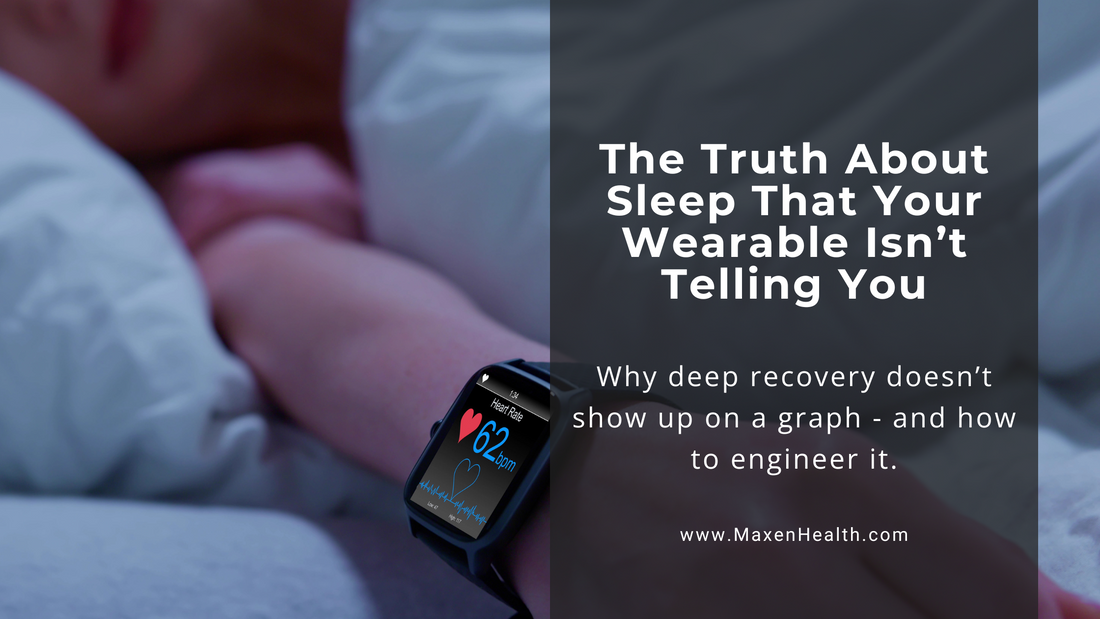
The Truth About Sleep That Your Wearable Isn’t Telling You
Share
Why deep recovery doesn’t show up on a graph - and how to engineer it.
You wake up, check your wrist, and see a green circle or a perfect score.
But you still feel tired.
Or worse, your wearable tells you your sleep was “poor”… yet you feel focused and energized.
So which is it?
The truth is: no device can measure what truly matters.
Because deep recovery isn’t just about stats. It’s about how your body feels, and how your mind functions, when you wake up.
The Problem: You’ve Outsourced Your Recovery to a Graph
We love data. We love optimization. We love improvement.
But we’ve become obsessed with tracking sleep… and in the process, we’ve lost touch with how to feel it.
- You check your deep sleep percentage more than your energy level
- You let your REM score dictate your mindset
- You overthink every red or yellow marker
What started as a tool for awareness has turned into a source of anxiety.
And anxiety is the exact thing that ruins your ability to recover.
Sleep tracking can help you notice patterns, sure.
But if it disconnects you from your body, your rhythm, or your self-trust, it’s working against you.
The Insight: Sleep Quality Can’t Be Fully Measured
Here’s the truth your wearable can’t show you:
- It can’t detect mental restfulness
- It can’t measure nervous system regulation
- It can’t tell you if you fell asleep with a racing mind
- It can’t track emotional recovery
That means your device might say you slept well—even if you woke up 3 times worrying about work.
And it might say your score is low—even if you feel sharp, focused, and aligned.
Deep sleep isn’t just a phase. It’s a state. And that state is influenced by behavior, not just biology.
The Action Plan: How to Engineer Recovery That Goes Beyond the Graph
Forget chasing perfect scores.
Let’s build rhythms that actually reset you.
1. Start Recovery Before You’re Tired
If you're waiting until 10:30 PM to “begin” your wind-down, you’re already too late.
Your brain needs time to disconnect from stimulation and shift into calm.
Do this:
- Set a “no scroll” cutoff 60 minutes before bed
- Dim the lights
-
Use a soft anchor habit: journal, stretch, or breathe for 2–3 minutes
- Take OVRNITE 30 minutes before bed to support a calm, natural transition into sleep
Coming Soon: "Don’t Start a Nighttime Routine. Start a Wind-Down Identity."
2. Ditch the Score-First Mentality
Instead of waking up and checking your numbers… check in with your body.
Ask:
- Do I feel clear-headed?
- Did I wake naturally or to an alarm?
- Do I feel emotionally calm or reactive?
Let your internal cues guide your rhythm more than the app.
3. Build a Nervous System That Feels Safe at Night
You can’t fall into deep sleep if your brain still thinks you’re under attack.
Most people are chronically wired before bed—not tired.
Do this:
- Breathe through your nose slowly for 2 minutes
- Practice gratitude or visualization (just 3 thoughts)
- Set your phone in another room
This tells your nervous system: “It’s safe to let go.”
Related post: "Your Phone Is Wrecking Your Nervous System (And Your Sleep)"
4. Consistency > Optimization
You don’t need a new gadget.
You need a repeatable rhythm that tells your body what to expect - every single night.
- Go to bed and wake up at the same time. Even on weekends
- Anchor your rhythm with light in the morning and calm in the evening
- Use OVRNITE not as a sleep hack, but as a rhythm support tool
Your best nights won’t always be the ones that scored the highest.
They’ll be the ones where you actually felt restored.
The Encouragement: You Don’t Need a Score to Validate Your Sleep
You don’t need a wearable to give you permission to feel rested.
You don’t need a perfect REM cycle to be productive.
You don’t need a tracker to tell you who you are.
You just need to reset.
When you return to rhythm...
When you build trust with your body...
When you create space for recovery instead of performing it for a device...
That’s when your life starts to shift.
If you want to feel truly recovered—not just “green-zoned” by a screen:
